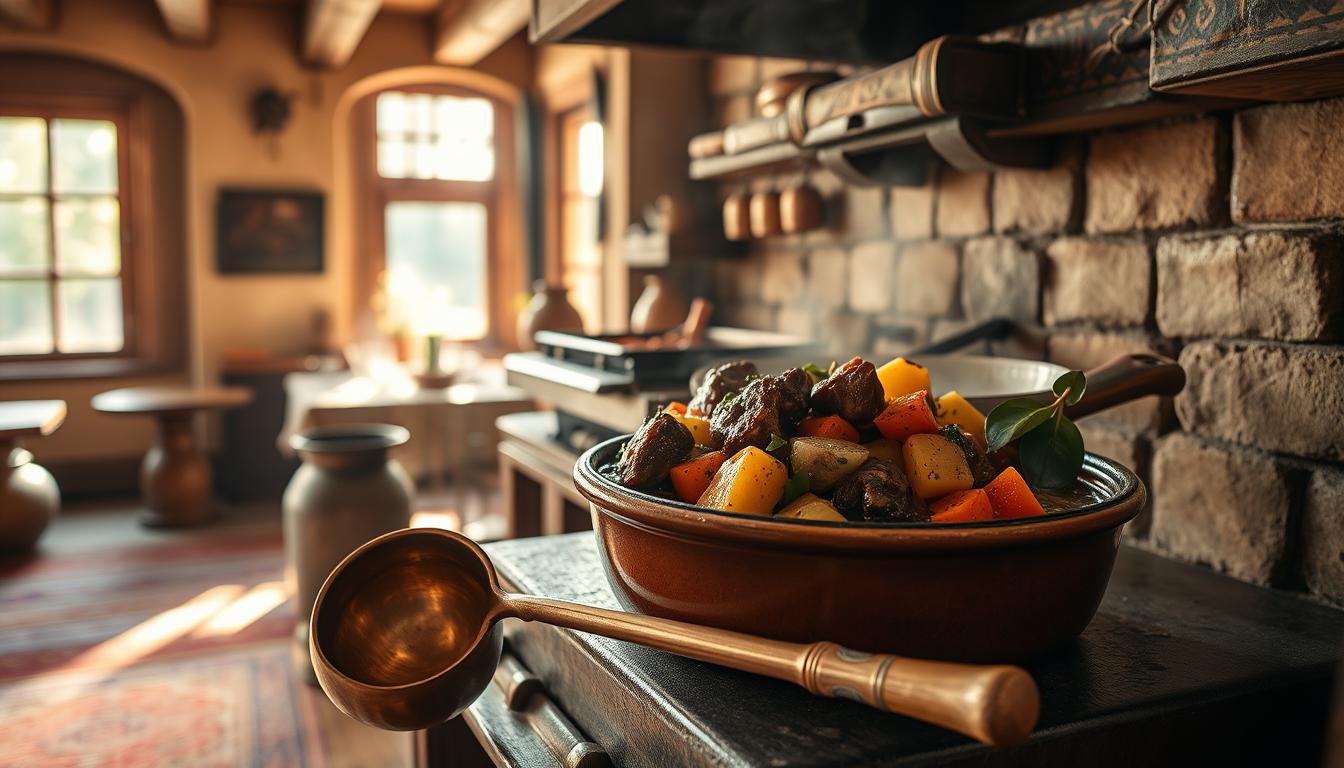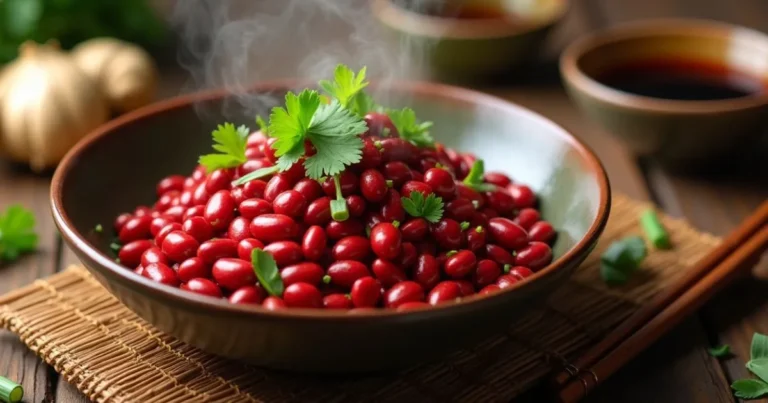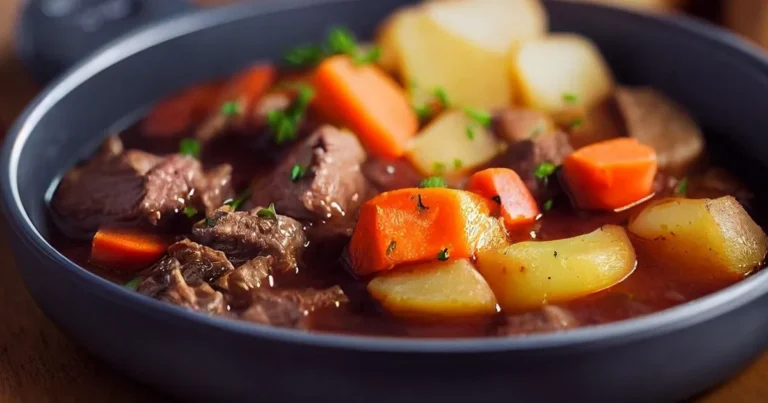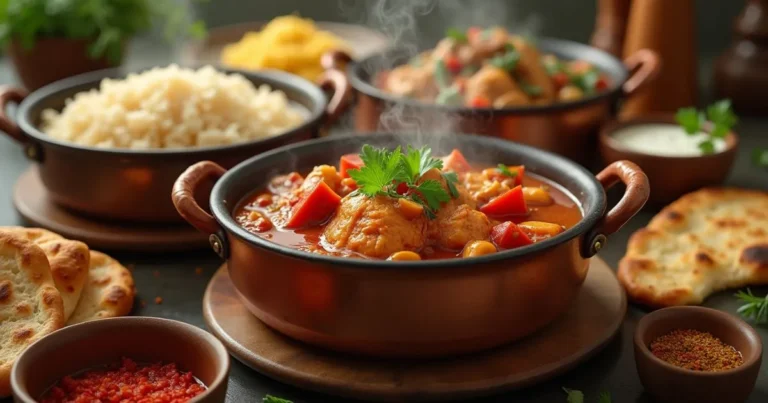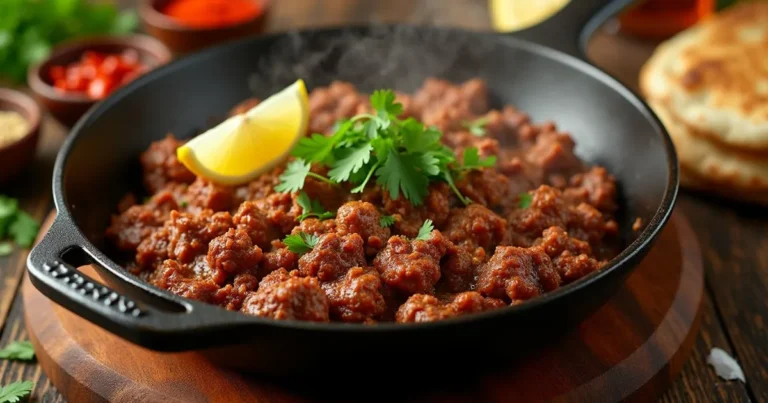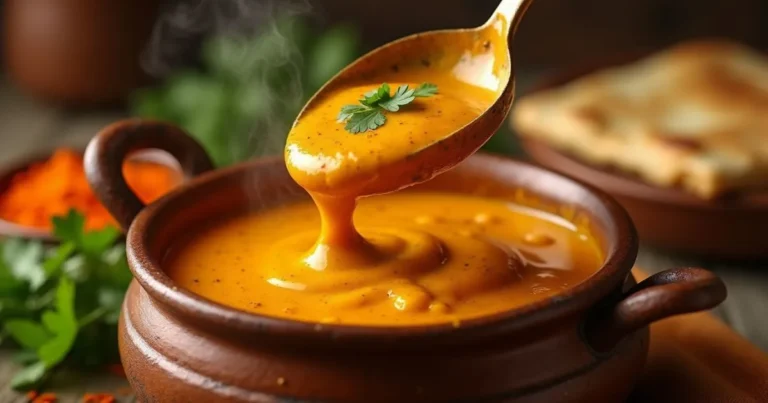Turkish Beef Stew: 5 Secrets for Rich Flavor & Warmth
The smell of simmering beef and spices in my grandmother’s kitchen brings back childhood memories. Turkish beef stew was more than food; it was a family tradition. It connected us across generations.

Imagine enjoying a hearty Turkish beef stew that tells a story with every bite. This dish, called güveç, is the heart of Turkish cooking. It combines strong flavors, chosen ingredients, and old cooking methods to create a special experience.
If you love cooking or want to try real Turkish cuisine, this guide is for you. It will show you how to make a beef stew that feels like a trip to Turkey.
Key Takeaways
- Discover the cultural significance of traditional Turkish beef stew
- Learn essential techniques for selecting premium beef cuts
- Understand the importance of slow cooking in developing deep flavors
- Explore authentic spices that elevate the beef stew recipe
- Master the art of creating a rich, complex sauce base
Understanding the Rich Heritage of Turkish Beef Stew
Turkish cuisine is a colorful mix of flavors, shaped by centuries of traditions. Turkish beef stew is more than a recipe. It’s a trip through time, culture, and the Mediterranean flavors that make it special.
The story of Turkish beef stew starts with the nomadic Turkic tribes of Central Asia. As they moved to Anatolia, they brought cooking methods that influenced Turkish food for many years.
Origins in Ottoman Empire Cuisine
In the Ottoman Empire, beef stew became a symbol of the area’s diverse cultures. The slow-cooking method became a key part of Turkish cooking. It showed the nomadic tribes’ need for filling meals made with little.
“Food is our common ground, a universal experience.” – James Beard
Cultural Significance in Turkish Cooking
- Central to family gatherings and celebrations
- Represents hospitality and community bonding
- Showcases the importance of shared meals
Evolution Through Generations
Turkish beef stew has changed over time, keeping its core but adapting to new tastes. Each generation adds its own twist, keeping the dish true to its roots while introducing new ideas.
| Era | Cooking Technique | Key Ingredients |
|---|---|---|
| Nomadic Period | Open fire cooking | Wild game, local herbs |
| Ottoman Empire | Clay pot slow cooking | Beef, local vegetables |
| Modern Turkey | Dutch oven, precision cooking | Diverse spice blends |
The journey of Turkish beef stew continues, a delicious narrative of cultural resilience and culinary creativity.
Essential Ingredients for Authentic Turkish Beef Stew

To make a real Turkish beef stew, you need to know the key ingredients. These ingredients are what make the stew rich and full of flavor. They turn simple parts into a dish that’s both tasty and aromatic.
Start your Turkish beef stew with top-notch ingredients. These are the heart of Mediterranean cooking. The main parts are:
- High-quality beef cuts
- Fresh seasonal vegetables
- Traditional Turkish spices
- Premium olive oil
The most important things for your stew are:
| Ingredient | Quantity | Purpose |
|---|---|---|
| Beef | 500 grams | Primary protein source |
| Pearl Onions | 300 grams | Sweet flavor base |
| Garlic | 4 cloves | Aromatic enhancement |
| Olive Oil | ½ cup | Cooking medium |
The secret to authentic Mediterranean flavors is using fresh, quality ingredients. Spices like paprika, sumac, and dried mint add a special touch. They make the stew’s flavor deep and unique.
When making your Turkish beef stew, pay attention to the ingredients and how you prepare them. Each part is important for the stew’s rich, comforting taste. This taste is what makes this dish so loved.
The Art of Selecting and Preparing the Perfect Beef Cuts
Making a great beef stew starts with picking the right meat. The beef cuts you choose will greatly affect the stew’s taste and softness. Knowing how to pick, trim, and prepare the beef is key for a memorable Turkish beef stew.
Choosing Premium Meat Cuts
For a beef stew, pick cuts with lots of marbling and connective tissue. The top choices are:
- Boneless sirloin tip
- Chuck roast
- Beef brisket
- Bottom round
Proper Trimming and Cubing Techniques
Good meat prep makes your stew tender and tasty. Here’s how to do it right:
- Take off extra fat, but keep a thin layer for flavor
- Cut the meat into even 3-5 cm cubes
- Make sure all cubes are the same size for even cooking
| Beef Cut | Cooking Time | Tenderness Level |
|---|---|---|
| Chuck Roast | 2-3 hours | High |
| Sirloin Tip | 1.5-2 hours | Medium |
| Brisket | 3-4 hours | Very High |
Meat Preparation Methods
Boost your stew’s flavor with smart prep methods. Searing the meat before slow cooking gives it a rich, caramelized outside. This keeps the meat moist and adds deep flavors. Try marinating your beef for even more tenderness and taste.
Traditional Spices and Aromatics
Discover the world of aromatic spices that make Turkish beef stew special. Mediterranean flavors blend in Turkish cuisine, turning simple ingredients into amazing dishes.
Starting your Turkish spice journey means learning about key flavor builders. These spices are more than just seasonings. They tell stories of generations of cooks.
- Aleppo Pepper: Mild heat with a smoky, fruity undertone perfect for adding depth
- Sumac: Tart and citrusy, bringing brightness to meat dishes
- Cumin (Kimyon): Earthy and warm, essential for rich meat preparations
- Dried Mint (Nane): Refreshing and slightly sweet, elevating soups and stews
- Turkish Oregano (Kekik): Robust and peppery, ideal for marinades
Professional chefs say making a balanced spice blend is key. A mix for kebabs includes paprika, cumin, sumac, pul biber, and black pepper. Each spice is chosen for its role in the flavor.
When making your beef stew, choose quality spices. They will make your dish taste more authentic. Keep your spices in airtight containers in a cool, dark spot to keep their flavors bright.
The Role of Fresh Vegetables in Turkish Beef Stew
Creating a real beef and vegetable stew needs the right vegetable choices and prep. Mediterranean flavors really come out when you pick the best seasonal ingredients and handle them well.
Fresh veggies turn a basic beef stew into a lively dish. Picking the right produce makes your stew taste like true Turkish cooking.
Seasonal Vegetable Selection
Your veggie choices are key to a great beef and vegetable stew. The top picks are:
- Potatoes (2 small, diced)
- Carrots (1 large, chopped)
- Bell peppers
- Tomatoes
- Celery
Proper Cutting Techniques
Even cuts mean even cooking and a nice look. Go for 1-inch chunks that cook with the beef.
Layering Order for Optimal Flavor
Mediterranean tastes come from layering smartly. Here’s the best order:
- Brown meat first
- Add root veggies
- Put in softer veggies halfway
- Delicate veggies last 20 minutes
Your veggie picks make a healthy meal with about 35g carbs and 9g fiber per serving.
| Vegetable | Preparation | Cooking Time |
|---|---|---|
| Potatoes | Diced 1-inch | Less than beef to prevent mushiness |
| Carrots | Chopped | Added halfway through cooking |
| Peas | Frozen | Last 20 minutes |
Mastering the Slow-Cooking Process
Slow-cooked meat dishes are at the heart of Turkish cuisine. They turn tough beef into tender, flavorful stews. The secret is in slow cooking, which breaks down meat and brings out deep flavors.
Choosing the right cooking method is key when making Turkish beef stew. Traditional güveç cooking uses low heat for 1.5 to 2 hours, around 375°F (190°C). This method ensures the meat is tender and full of flavor.
- Best beef cuts for slow cooking:
- Chuck roast
- Short ribs
- Beef shank
- Brisket
The cooking vessel is important for authentic slow-cooked dishes. Here are some options:
| Cooking Method | Temperature | Cooking Time |
|---|---|---|
| Clay Pot (Traditional) | 375°F | 1.5-2 hours |
| Stovetop | Low-Medium | 2-3 hours |
| Oven | 325-350°F | 2-2.5 hours |
“Patience transforms ordinary meat into extraordinary comfort.” – Turkish Culinary Wisdom
Keep an eye on your stew. Look for signs like meat that falls apart easily and a thick sauce. The key is maintaining consistent, low heat that allows flavors to develop gradually.
Cooking Vessel Selection: Clay Pots vs Modern Alternatives
Exploring Turkish culinary traditions shows the importance of cooking vessels. The right pot can make your stews taste better and feel more authentic. It’s all about the cooking vessel.
Cooking vessels have a long history, with clay pots dating back about 6000 years. They connect us to traditional cooking. Clay pots offer benefits that modern cookware can’t match.
Benefits of Traditional Clay Pots
Clay pots are great for making Turkish beef stew:
- Even heat distribution
- Exceptional moisture retention
- Natural flavor enhancement
- Nutrient preservation
The porous clay of these pots helps flavors develop slowly. Güveç, the traditional earthenware pot, is key to Turkish cooking.
Modern Cookware Options
If you don’t have clay pots, there are good alternatives:
| Cookware Type | Heat Retention | Flavor Development |
|---|---|---|
| Cast Iron Dutch Oven | Excellent | Very Good |
| Enameled Cast Iron | Good | Good |
| Stainless Steel Pot | Fair | Moderate |
When picking a cooking vessel, think about heat, material, and your cooking style. This helps make stews that honor traditional cooking.
Secret Techniques for Tender, Flavorful Meat
Making the perfect beef stew recipe is all about mastering a few key techniques. These secrets turn simple slow-cooked dishes into unforgettable meals. The key to tender meat is in how you prepare and cook it.
Begin by picking the right beef cuts. For a great beef stew, go for boneless beef chuck or bottom round. These cuts become incredibly tender when cooked slowly. Before adding the meat to your pot, remember these important steps:
- Pat the beef dry with paper towels to ensure proper browning
- Cut meat into uniform 1-inch cubes for even cooking
- Season generously with salt and pepper
Browning is key to making your meat dishes full of flavor. Sear the beef cubes in a hot pan with a small amount of oil until they develop a rich, golden-brown crust. This step, called the Maillard reaction, enhances flavor and gives your stew a strong taste.
For even more tender meat, try these advanced techniques:
- Marinate the beef for 2-4 hours using acidic ingredients like tomato sauce or wine
- Cook at a low temperature (around 325°F) to break down tough muscle fibers
- Allow sufficient cooking time – approximately 2 hours for optimal tenderness
By using these expert methods, your beef stew will become a dish that’s both tender and full of flavor. It will be so good, it’ll fall apart with every bite.
The Perfect Sauce Base for Turkish Beef Stew
Making a great sauce base is key to a delicious Turkish beef stew. It’s all about building rich, complex flavors. These flavors turn a simple dish into a masterpiece.
The best Turkish beef stew sauce starts with the right ingredients. These ingredients capture the essence of traditional cooking.
Building Flavor Layers
To make a true sauce base, focus on important ingredients. These are what make Turkish cooking special:
- High-quality tomato paste
- Red pepper paste (both sweet and hot varieties)
- Fresh garlic
- Aromatic spices
Proper Liquid Ratios
Getting the right sauce consistency is all about liquid balance. Your stew needs a mix of:
- Beef broth (60% of liquid base)
- Water (30% of liquid base)
- Wine or additional flavor enhancers (10% of liquid base)
Pro tip: Deglazing the cooking pot captures those critical browned bits that add depth and richness to your sauce. This method makes sure every flavor counts in your Turkish beef stew.
By choosing the right ingredients and understanding sauce balance, you’ll make a dish that’s truly memorable. It will honor Turkish cooking traditions.
Incorporating Regional Variations
Turkish cuisine is incredibly diverse, especially in traditional beef stew. Each region adds its own special touch to this dish. This turns a simple recipe into a journey through Turkey’s flavors.
Coastal areas have stews with seafood and fresh Mediterranean ingredients. Eastern Anatolia, on the other hand, makes stews with strong spices and legumes. This reflects the mountainous landscape.
- Coastal regions: Lighter stews with seafood elements
- Eastern regions: Spicier, meat-heavy versions
- Central Anatolia: Stews featuring local herbs and dairy
- Southeastern regions: Spice-rich preparations with Kurdish influences
The Black Sea region uses corn in their stews. The Aegean areas add olive oil and fresh herbs. These differences highlight the depth of Turkish culinary traditions.
| Region | Stew Characteristic | Unique Ingredient |
|---|---|---|
| Black Sea | Hearty, thick consistency | Cornmeal |
| Aegean | Light, herb-infused | Fresh herbs, olive oil |
| Eastern Anatolia | Spicy, meat-focused | Additional spices |
| Southeastern | Rich, complex flavors | Kurdish spice blends |
Learning about these regional variations lets you dive into Turkish cuisine’s rich world. Each recipe shares a story of local ingredients, cultural influences, and culinary traditions passed down through generations.
“In Turkey, a stew is more than food—it’s a map of cultural heritage.” – Turkish Food Historian
Serving Suggestions and Accompaniments
Your Turkish beef stew is ready to be enjoyed with the perfect sides. Turkish cuisine loves to share meals, making a simple stew into a special occasion. It’s a time to gather and enjoy good food together.
- Crusty pide bread for soaking up flavorful juices
- Fluffy white rice or traditional bulgur pilaf
- Fresh green salad with cucumber and tomatoes
- Yogurt-based side dishes like cacık
Traditional Side Dishes
Choosing the right sides can make your meal even better. Different regions in Turkey offer their own special sides. These add to the stew’s flavor and make it more interesting.
| Region | Typical Side Dishes |
|---|---|
| Central Anatolia | Bulgur pilaf, pickled vegetables |
| Mediterranean Coast | Herb salads, grilled vegetables |
| Eastern Turkey | Lavash bread, spicy pepper spreads |
Bread and Rice Pairings
In Turkish cuisine, bread is more than a side—it’s a key part of the meal. You can choose fluffy rice, traditional pilaf, or crusty bread. Each one adds a different texture that goes well with the tender beef and rich sauce.
Pro tip: Warm your bread or rice before serving. It makes the meal even better and keeps the stew warm.
Storage and Reheating Guidelines
Keeping your meals tasty means storing and reheating them right. Your Turkish beef stew stays yummy for days if you do it correctly.
Keeping it in the fridge is crucial. Put the stew in a sealed container within 2 hours of cooking. Here’s how long it lasts:
- Refrigerator: Up to 3 days
- Freezer: Up to 3 months
When you reheat, follow these food safety tips:
- Reheat to 75°C (165°F)
- Stir often for even heat
- Check with a meat thermometer
- Reheat only once to avoid bacteria
Pro tip: Güveç tastes better the next day as flavors deepen!
Proper storage makes your meals go from good to great.
Reheating methods depend on your kitchen:
- Stovetop: Warm on medium, stir now and then
- Oven: Reheat at 350°F, add broth to keep moist
- Microwave: Medium power, stir every 30 seconds
By sticking to these tips, you’ll enjoy safe, tasty Turkish beef stew every time.
Health Benefits of Turkish Beef Stew
Discover the nutritional powerhouse behind these hearty meals rooted in Mediterranean flavors. Turkish beef stew is more than just tasty—it’s a balanced meal full of essential nutrients. The lean beef gives you high-quality protein, which is key for muscle health and recovery.
The diverse vegetables add vital vitamins and minerals. Your body benefits from the slow-cooking process. It breaks down proteins and makes nutrients easier to use.
The spices like cumin, paprika, and oregano add anti-inflammatory compounds. These support your overall wellness. These Mediterranean flavors do more than just taste good—they’re a holistic approach to nutrition.
This beef stew follows the Mediterranean diet, making it a nutrient-dense meal. It supports heart health. The vegetables, lean protein, and spices work together to nourish your body and soul.
By choosing wholesome ingredients and traditional cooking methods, you’re investing in your health. Each serving of this traditional Turkish stew is a culinary tradition that values fresh, high-quality ingredients. It transforms simple components into a nutritious meal that supports your wellness journey.
FAQ
What makes Turkish beef stew different from other beef stews?
Turkish beef stew stands out because of its unique spices and slow cooking. It uses traditional Ottoman spices like cumin, paprika, and red pepper flakes. This gives it a richer taste than other stews.
The cooking method, often in clay pots, adds to its uniqueness. It uses specific vegetables, making it different from Western stews.
How long does it take to prepare an authentic Turkish beef stew?
Preparing a traditional Turkish beef stew takes about 2-3 hours. This includes chopping veggies and browning the meat. The slow cooking part takes 1.5 to 2 hours.
Patience is key to get the rich flavors of this classic dish.
Can I make Turkish beef stew if I don’t have a clay pot?
Yes, you can make Turkish beef stew without a clay pot. Dutch ovens, cast-iron pots, or slow cookers work well. The key is to keep the heat low and even.
Follow the traditional layering and cooking methods to get the authentic flavor.
What are the best beef cuts for Turkish beef stew?
The best cuts are chuck roast, beef shoulder, or shanks. These have good marbling and connective tissue. They become tender during slow cooking.
Choose cuts with fat for richer flavor and moist meat.
Are there vegetarian alternatives to traditional Turkish beef stew?
Yes, you can make vegetarian versions with mushrooms, eggplant, or jackfruit. Use the same spices and cooking methods. Legumes like chickpeas or white beans add protein.
How should I store leftover Turkish beef stew?
Store leftovers in an airtight container in the fridge for 3-4 days. Freeze for up to 3 months. Reheat slowly over low heat, adding broth if needed.
Many find it tastes better the next day as flavors meld together.
What are the most important spices for authentic Turkish beef stew?
Key spices include red pepper flakes, cumin, paprika, black pepper, and oregano. Garlic, bay leaves, and cinnamon add depth. These spices create the unique flavor of Turkish beef stew.

